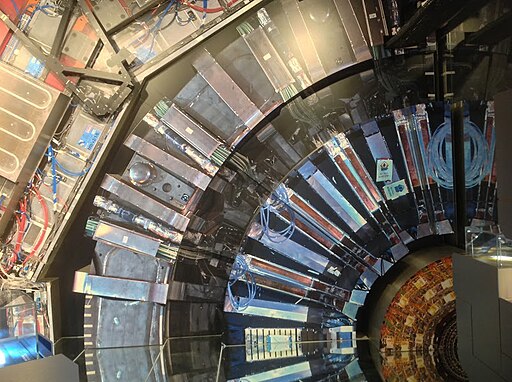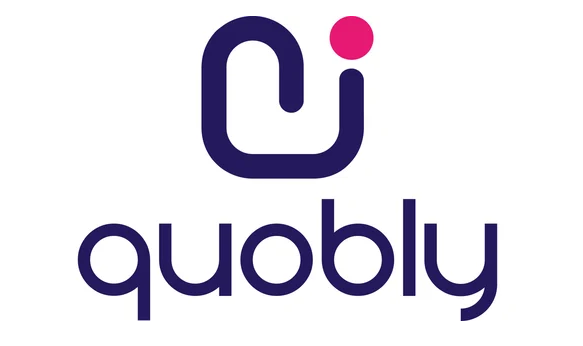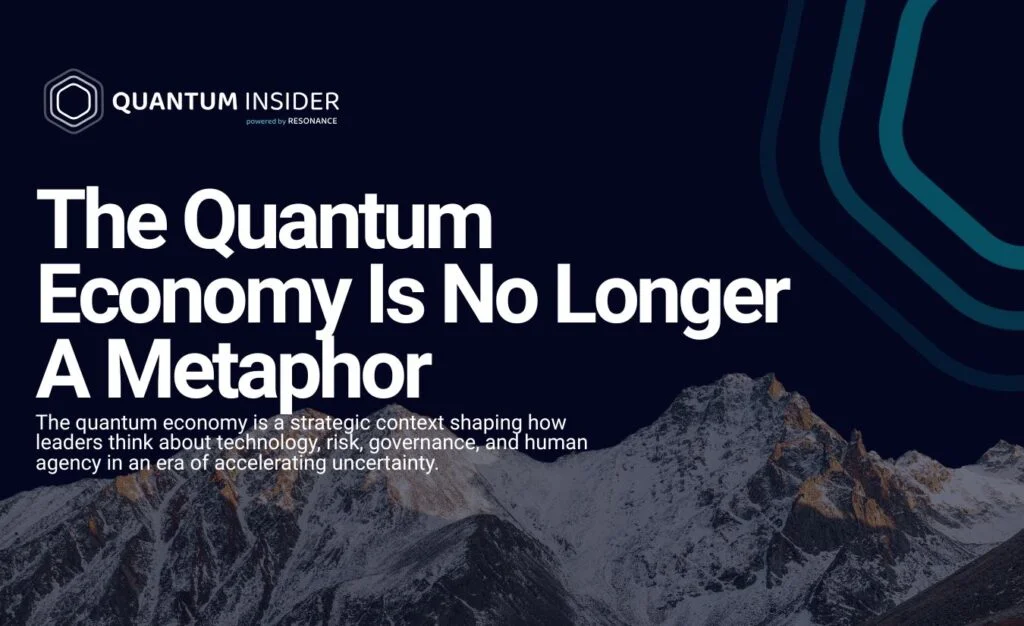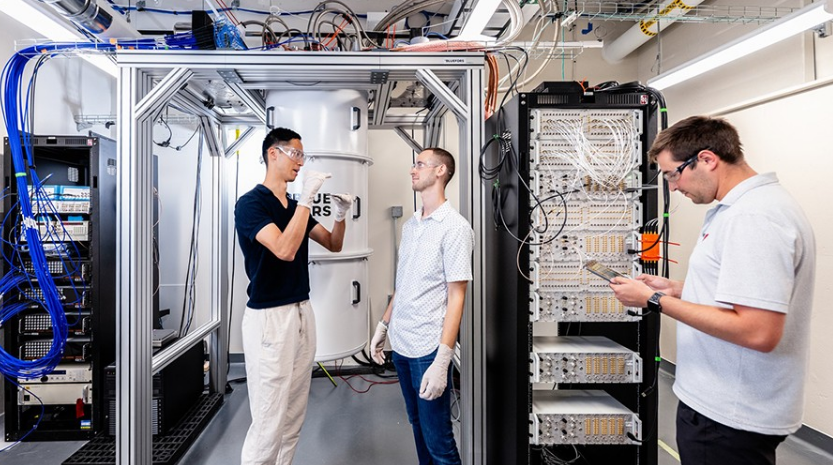Insider Brief
- A recent study demonstrates how quantum machine learning (QML) can be used to detect anomalies in data from the Large Hadron Collider (LHC), potentially leading to the discovery of new physics beyond the Standard Model.
- The researchers implemented quantum kernel machines and clustering algorithms on IBM’s quantum computers, showing that quantum models can outperform classical methods in identifying rare events when more quantum resources, such as qubits and entanglement, are utilized.
- By leveraging unsupervised learning, the QML approach allows for model-independent searches, reducing bias toward predefined signals and increasing the chances of discovering unexpected phenomena in high-energy particle collisions.
- Image: Wikimedia Commons (Vieamusanta under the Creative Commons Attribution-Share Alike 4.0 International license)
The Large Hadron Collider (LHC) is a mind-bending device designed to probe the very essence of reality. The data it produces isn’t just mind-bending, it’s often so rich and so complex that it outstrips classical computational processes for analyzing and visualizing that information.
A team of ETH Zurich and CERN-led scientists report the ongoing search for new phenomena at the Large Hadron Collider (LHC) demands advanced computational methods to handle the enormous amounts of data generated from high-energy particle collisions. Traditional machine learning approaches have helped in analyzing this data, but new computational technologies, like quantum machine learning (QML), are showing potential to boost the process, making it more efficient and revealing previously unseen patterns.
Now, in a recent study published in Nature, the scientists say QML could be applied to search for new physics beyond the Standard Model (BSM) and — in possibly a case of “it takes quantum to know quantum” — using quantum computing to enhance anomaly detection in LHC data.

The study focuses on using unsupervised quantum machine learning algorithms for anomaly detection, a technique designed to identify unusual events in a dataset that might signify new physics. These algorithms were implemented using IBM’s quantum hardware, leveraging quantum computers’ ability to process data in fundamentally different ways from classical computers.
The results suggest that quantum algorithms could provide a significant advantage in identifying rare events in the chaotic environment of high-energy particle collisions.
The Challenge of Finding New Physics
At the heart of modern particle physics lies the Standard Model, a well-established theory that describes the fundamental particles and forces of the universe. However, the Standard Model is incomplete—it does not explain phenomena such as dark matter, the origin of neutrino masses, or the force behind dark energy. Physicists at the LHC collide protons at extremely high energies to recreate conditions similar to those in the early universe, with the hope of discovering new particles or forces that could answer these unsolved questions.
Traditionally, machine learning algorithms used at the LHC are trained on simulations of known particle interactions, allowing them to distinguish between familiar background events and hypothetical signals of new physics. However, these algorithms are supervised—they rely on labeled data and are designed to detect specific, predefined signals. This limits their ability to identify unexpected phenomena, as they are biased toward the types of events they were trained to recognize.
To address this limitation, the researchers used an unsupervised learning approach, which does not require labeled data. Instead of looking for a specific signal, this approach detects any event that deviates significantly from what is expected. This method, called anomaly detection, is particularly useful in situations where physicists are searching for unknown signals of new physics, which may not fit into existing models.
How Quantum Machine Learning Can Help
Quantum computing is a rapidly developing field that exploits the unique properties of quantum mechanics to perform certain calculations much faster than classical computers. One of the key features of quantum computing is the concept of qubits—quantum bits that, unlike classical bits, can exist in multiple probabilistic states, thanks to the phenomenon of superposition. Qubits can also become entangled, meaning the state of one qubit correlates with the state of another, no matter the distance between them. These properties allow quantum computers to explore multiple solutions to a problem in ways that classical computers can’t.
In this study, the researchers used quantum kernel machines and quantum clustering algorithms to process LHC data. These quantum models were trained to detect anomalies in a compressed version of the data, known as a latent space, generated by an autoencoder. An autoencoder is a type of neural network that reduces the dimensionality of data, simplifying it while preserving important information. The researchers designed the autoencoder to be compatible with the limitations of current quantum hardware, which can only handle relatively small datasets.
The researchers demonstrated the quantum models’ effectiveness by running them on IBM’s quantum computers. Specifically, they used IBM’s ibm_toronto quantum processor, a device based on superconducting qubits—a type of qubit that operates at extremely low temperatures to maintain quantum coherence. This allowed the team to test their quantum anomaly detection algorithms on real quantum hardware, rather than relying solely on simulations, the team writes in the paper.
Quantum Kernels and Clustering Algorithms
The study focused on two types of quantum models for anomaly detection: quantum kernel machines and quantum clustering algorithms.
A kernel machine is a type of algorithm used in machine learning for tasks like classification. In a quantum kernel machine, the data is embedded into quantum states, and the relationships between data points are analyzed using the unique properties of quantum mechanics, such as entanglement. The quantum kernel machine in this study was designed to detect patterns in the LHC data that may indicate the presence of new physics. The team found that as they increased the number of qubits and the level of entanglement, the quantum kernel machine’s performance improved, surpassing that of classical models in identifying anomalies.
The quantum clustering algorithms, such as Quantum K-means and Quantum K-medians, group data points based on their similarity, according to the study. These algorithms operate similarly to their classical counterparts but take advantage of quantum computers’ ability to process large amounts of data simultaneously. In this study, the clustering algorithms were used to identify patterns in the latent space, which could indicate the presence of BSM events.
Results and Implications
The study’s findings suggest that QML has significant potential for detecting new physics at the LHC. The quantum kernel machine, in particular, demonstrated superior performance to classical methods, especially as the number of qubits and the level of quantum entanglement increased. The researchers found that as more quantum resources were used, the model’s ability to detect anomalies improved.
Importantly, the team writes that they were able to implement their quantum models on IBM’s quantum hardware, demonstrating that these techniques can be applied in real-world settings, despite the current limitations of quantum computers. Overall, the study offers a glimpse into the potential for quantum computing to play a key role in high-energy physics, particularly in the search for new particles and forces that lie beyond the Standard Model.
Future Directions
While the study demonstrates the potential of QML for anomaly detection in LHC data, there is still a lot of room for future research. One key area is exploring other classical algorithms, such as tensor networks, to see if they can achieve similar or better performance. Additionally, future studies could investigate QML models specifically tailored to the unique structure of high-energy physics data, which could further enhance performance.
Right now, quantum computing is still in its nascent stages and faces problems with environmental noise that make quantum calculations less reliable than their classical counterparts. The researchers’ approach may therefore be difficult to scale realistically. However, as quantum hardware continues to improve, the team writes that QML could become an increasingly important tool for researchers in their search for new physics.
The study was conducted by a collaboration of researchers from several institutions. Vasilis Belis and Günther Dissertori are affiliated with the Institute for Particle Physics and Astrophysics at ETH Zurich. Kinga Anna Woźniak, Ema Puljak, Michele Grossi, Maurizio Pierini, and Sofia Vallecorsa are based at the European Organization for Nuclear Research (CERN). Additionally, Woźniak is also affiliated with the Faculty of Computer Science at the University of Vienna, and Puljak is affiliated with the Departamento de Física at Universitat Autònoma de Barcelona. Panagiotis Barkoutsos and Ivano Tavernelli are from IBM Quantum, IBM Research—Zurich, while Florentin Reiter is affiliated with the Institute for Quantum Electronics at ETH Zurich.

















